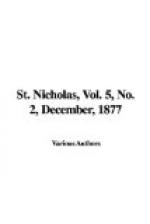“The name is derived from the Spanish island of Majorca in the Mediterranean Sea, one of the places in Europe where glazed pottery was first made. About the twelfth century, some Moorish potters had settled there and carried their art with them.”
“Did you ever see any of the old Italian majolica, uncle?” asked Al.
“Yes; in the splendid Castellani collection there are some of the very best specimens of the finest majolica ever made,—that produced in the fifteenth century by Giorgio Andreoli of Gubbio, and others who followed him.”
“Where is Gubbio?” asked Al.
“In Italy.”
“Is the Castellani collection in Italy?”
“No, it’s at the Metropolitan Museum, too; but only on loan at present, though an effort is being made to purchase and keep it in this country forever. I hope it will be successful, for it is a grand collection. But I must tell you that when the French came to manufacture majolica, most of which by that time was made in the little Italian town of Faenza, they called the ware faience, after it. This name is applied to most soft paste glazed pottery, while majolica is a ware that has a peculiar luster, and in different lights displays all the colors of the rainbow. Much ordinary glazed, unlustered pottery is incorrectly called majolica, however.”
“How do they make the luster, uncle?”
“By coating the ware with certain metallic oxides, which, at the last of the many necessary firings, diffuses a glaze over the surface.”
“You said the painting was one of the ‘nice points of the ceramic art,’ uncle. What does ‘ceramic’ mean?” asked Willie.
“It is sometimes spelled K-e-r-a-m-i-c, keramic, and comes from the Greek word cheramos, signifying ‘potters’ clay,’ and hence, in a general sense, pottery of every kind and methods of producing it.”
Here Matie, who had been hugging her little pug for some time, began to grow very sleepy, so Uncle Jack dismissed the children with a “good-night” all around.
The door closed softly, and the little ones ran off to their beds, while Uncle Jack leaned back in his easy chair in a pleasant reverie, which we will leave him to enjoy.
POEMS BY TWO LITTLE AMERICAN GIRLS.
[ELAINE AND DORA READ GOODALE, the two sisters some of whose poems are here given for the benefit of the readers of ST. NICHOLAS, are children of thirteen and ten years of age.
Their home, where their infancy and childhood have been passed, is on a large and isolated farm, lying upon the broad slopes of the beautiful Berkshire hills of western Massachusetts, and is quaintly called “Sky Farm.”
Here, in a simple country life, divided between books and nature, they began, almost as soon as they began to talk, to express in verse what they saw and felt, rhyme and rhythm seeming to come by instinct. Living largely out-of-doors, vigorous and healthful in body as in mind, they draw pleasure and instruction from all about them.




